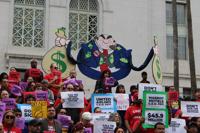When addressing Latinos living in the U.S., it is evident that a uniform approach is ineffective in reaching the expansive Latino diaspora. Diversity stands as a fundamental factor when engaging with Latinos. Furthermore, there’s a misconception that the Latino market should be exclusively addressed in one language — namely, Spanish.
The Latino market is intricate, but don’t let its complexity deter you from engaging with this diverse group. Just like the general market, it’s multifaceted. Presently, the Latino market boasts a staggering 63 million individuals, constituting 19% of the total U.S. population. Reflect on this: nearly 1 in 5 Americans identify as Latino. If you’re not actively engaging with this substantial demographic, you’re missing out on a golden opportunity to tap into this $2 trillion segment and drive significant revenue.
According to a recent Pew Research Center study, within the Latino population, approximately 68% speak Spanish as their primary language at home. Nevertheless, the proportion of Latinos proficient in English is on the rise. In 2022, 72% of Latinos aged 5 and above demonstrated English proficiency, marking a notable increase from 59% in the year 2000. This growth is predominantly propelled by U.S.-born Latinos. In total, 42.3 million Latinos in the U.S. showcased English proficiency in 2022. Out of this cohort, 47% are bilingual, and a significant majority of U.S. Latinos (63%) acknowledge employing Spanglish at least occasionally, with 40% using it frequently.
The contemporary Latino consumer epitomizes cultural diversity and multilingualism, embodying what is often referred to as the 200% Generation. Whether born in the U.S. or brought here as children (Dreamers), we seamlessly straddle two worlds: the American lifestyle when we step outside, and our roots, food, culture, and parents’ mother tongue when we return home.
As part of this 200% Generation, we cherish our complete identity. We proudly embrace being 100% Latino and 100% American. We indulge in hamburgers and hotdogs as much as we delight in tacos and pupusas.
It’s crucial for major brands in the U.S. to grasp the intricate and nuanced characteristics of today’s Latinos. A significant majority of us are fully bilingual, effortlessly dreaming and thinking in both languages simultaneously.
If you’re reading this piece, you most likely are a 200 percenter. You are bilingual and bicultural, and you were either born in the U.S. or a different country but have spent a significant amount of time in the U.S. You consider this country your home.
Additional examples of this generation are people like América Ferrera, Eva Longoria, John Leguizamo, Selena Gomez, Mario Lopez, George Lopez, Melissa Barrera, Mishel Prada, Becky G, Selena and so many more.
In 2023, it’s evident that engaging the Latino consumer demands creativity across the spectrum, from bilingual advertisements to our unique Spanglish dialect. This approach resonates equally with a Newyorican on the Northeast Coast as it does with a Central American or Mexican on the West Coast. Today’s Latino consumer rejects being confined to one-dimensional stereotypes.
We consume media in Spanish and English, effortlessly navigating both mainstream and Latino cultures while embracing the bicultural dualities that shape our identity. Brands like Curacao here in Los Angeles understand this distinct cultural nuance and have tailored their marketing strategy when it comes to approaching this 21st-century Latino consumer. Other national brands like Toyota, AT&T, PepsiCo, Bank of America, or sports franchises like LAFC and Los Angeles Chargers, all understand that the new Latino consumer is not one-dimensional and likes to be addressed bilingually or in Spanglish.
As we move forward, we want our 200% generation to understand that they are a commodity in the marketplace and should never give up any part of their authentic self or change who they are. If corporate America wants our business and sees us as a valuable consumer, they must fully understand who we are outside of Hispanic Heritage Month. They need to do a better job every month of having people from our community that look like us and understand our cultural diaspora on their executive boards and in their C-suites to truly connect with us and have authentic and meaningful relationships with our community.











(0) comments
Welcome to the discussion.
Log In
Keep it Clean. Please avoid obscene, vulgar, lewd, racist or sexually-oriented language.
PLEASE TURN OFF YOUR CAPS LOCK.
Don't Threaten. Threats of harming another person will not be tolerated.
Be Truthful. Don't knowingly lie about anyone or anything.
Be Nice. No racism, sexism or any sort of -ism that is degrading to another person.
Be Proactive. Use the 'Report' link on each comment to let us know of abusive posts.
Share with Us. We'd love to hear eyewitness accounts, the history behind an article.